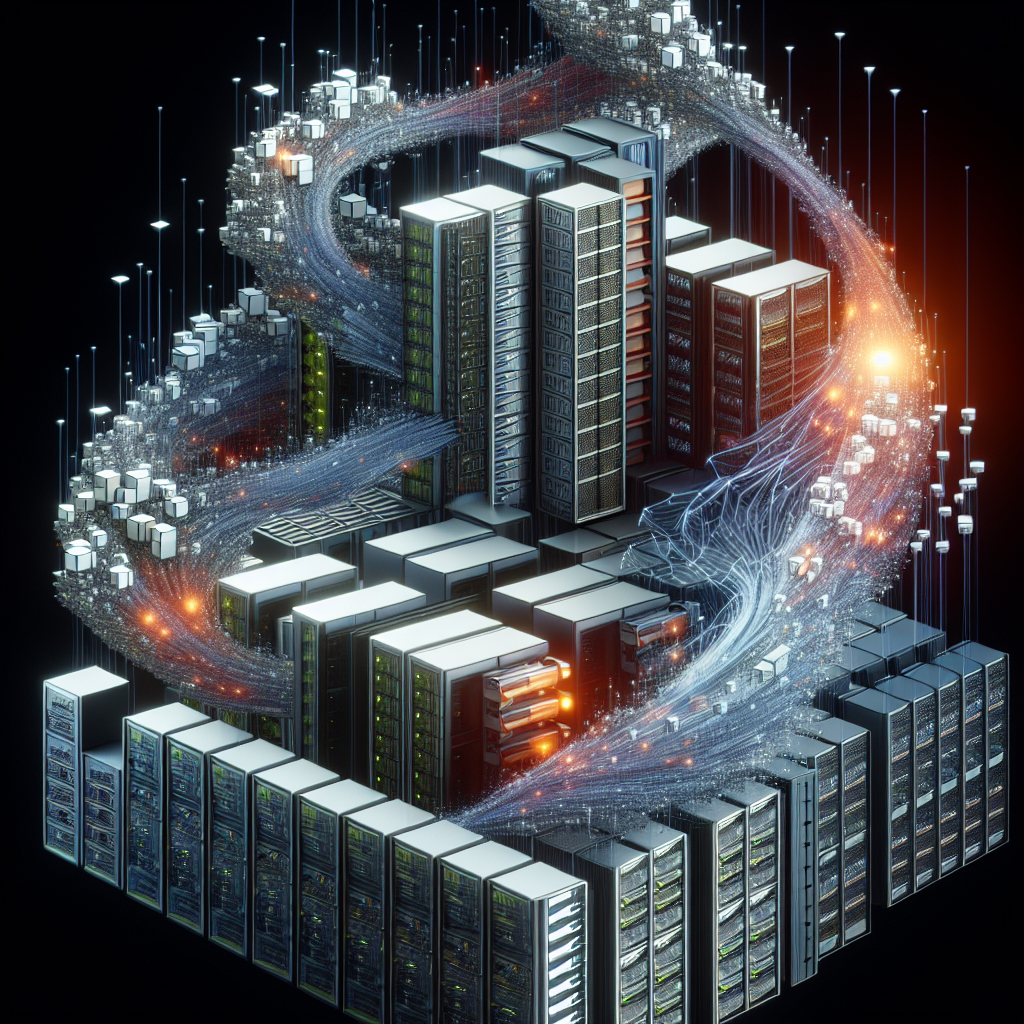Your cart is currently empty!
Tag: Scalability

Managing Scalability and Growth in Data Center IT Operations
In today’s fast-paced and highly competitive business environment, managing scalability and growth in data center IT operations is crucial for ensuring that organizations can keep up with the increasing demands of their customers and stakeholders. With the exponential growth of data being generated and processed every day, data centers must be equipped to handle this influx of information without compromising on performance or security.One of the key challenges in managing scalability and growth in data center IT operations is ensuring that the infrastructure can handle the increasing workload without experiencing any downtime or performance issues. This requires careful planning and regular monitoring of the data center environment to ensure that resources are being utilized effectively and efficiently.
To effectively manage scalability and growth in data center IT operations, organizations should consider implementing a few key strategies:
1. Virtualization: Virtualization technology allows organizations to consolidate their physical servers and storage devices into virtual machines, which can then be managed more efficiently and dynamically. This can help organizations scale their infrastructure as needed without having to invest in additional hardware.
2. Cloud Computing: Cloud computing offers organizations the flexibility to scale their IT infrastructure on-demand, allowing them to quickly ramp up resources during peak periods and scale down during slower times. This can help organizations save costs and improve overall efficiency.
3. Automation: Automation tools can help streamline IT operations and reduce the manual effort required to manage and scale the data center environment. By automating routine tasks such as provisioning, monitoring, and maintenance, organizations can free up their IT teams to focus on more strategic initiatives.
4. Scalable Networking: Ensuring that the data center network is scalable is essential for handling the increasing traffic and data volumes. Organizations should invest in scalable networking solutions that can accommodate growing bandwidth requirements and support high-speed connectivity.
5. Disaster Recovery Planning: In order to ensure business continuity and data protection, organizations should have a robust disaster recovery plan in place. This plan should include regular backups, data replication, and failover mechanisms to ensure that data can be recovered quickly in the event of a disruption.
Overall, managing scalability and growth in data center IT operations requires a proactive approach and a commitment to investing in the right technologies and strategies. By focusing on virtualization, cloud computing, automation, scalable networking, and disaster recovery planning, organizations can ensure that their data center infrastructure is equipped to handle the demands of today’s digital economy.

Scalability and Flexibility: Key Considerations for Data Center Database Design
In today’s digital age, data is king. From customer information to transaction records, organizations rely heavily on databases to store and manage their valuable data. However, as data volumes continue to grow exponentially, the need for scalable and flexible database design in data centers has become more important than ever.Scalability and flexibility are two key considerations that organizations must keep in mind when designing a database for their data center. Scalability refers to the ability of a database to handle increasing amounts of data and traffic without sacrificing performance. Flexibility, on the other hand, refers to the database’s ability to adapt to changing business requirements and data structures.
When it comes to scalability, there are several factors to consider. First and foremost, organizations should choose a database system that can scale horizontally, meaning it can distribute data across multiple servers to handle increased loads. This approach allows for better performance and reliability, as it reduces the risk of a single point of failure.
Additionally, organizations should consider the ability of the database to scale vertically, meaning it can handle increased data volumes within a single server. This can be achieved through hardware upgrades, such as adding more memory or storage to the server.
Flexibility is equally important when designing a database for a data center. Organizations should choose a database system that supports a wide range of data types and structures, as well as the ability to easily add or modify schemas as needed. This ensures that the database can adapt to changing business requirements and data sources without requiring a complete overhaul.
Furthermore, organizations should consider the flexibility of the database in terms of deployment options. Cloud-based databases, for example, offer greater flexibility in terms of scalability and resource allocation, as organizations can easily scale their databases up or down based on their needs.
Overall, scalability and flexibility are key considerations when designing a database for a data center. By choosing a database system that can handle increasing data volumes and adapt to changing business requirements, organizations can ensure that their data remains secure, accessible, and reliable in the long run.

Scalability and Flexibility: How Data Center Servers Adapt to Changing Business Needs
In today’s fast-paced and ever-changing business environment, organizations need data center servers that can easily adapt to their evolving needs. Scalability and flexibility are two key factors that play a crucial role in ensuring that data center servers can meet the demands of a growing business.Scalability refers to the ability of a system to handle an increasing amount of work or its potential to accommodate growth. This is particularly important for businesses that are experiencing rapid expansion or fluctuating workloads. Data center servers that are scalable can easily adjust to accommodate increased traffic, storage needs, or processing power without compromising performance.
Flexibility, on the other hand, refers to the agility of a system to adapt to changing requirements or environments. In the context of data center servers, flexibility allows organizations to easily add or remove resources, integrate new technologies, or make adjustments to meet specific business needs. This is essential for businesses that operate in dynamic industries or face unpredictable challenges.
One of the key ways data center servers achieve scalability and flexibility is through virtualization technology. Virtualization allows organizations to create virtual instances of servers, storage, and networking resources, which can be easily scaled up or down based on demand. This not only improves resource utilization but also enables organizations to quickly adapt to changing business needs without the need for physical hardware upgrades.
Another important factor in ensuring scalability and flexibility in data center servers is cloud computing. Cloud services provide organizations with on-demand access to a wide range of resources, allowing them to quickly scale their operations up or down as needed. Cloud computing also offers flexibility in terms of deployment options, allowing organizations to choose between public, private, or hybrid cloud models based on their specific requirements.
Additionally, modern data center servers are designed with modular architectures that allow for easy upgrades and expansions. This means that organizations can easily add new components, such as additional storage or processing units, to their servers without disrupting operations. This modularity also enables organizations to future-proof their infrastructure by allowing them to adapt to new technologies or trends as they emerge.
In conclusion, scalability and flexibility are essential features that organizations should look for in their data center servers. By ensuring that their servers can easily adapt to changing business needs, organizations can stay competitive, agile, and responsive in today’s fast-paced business landscape. Investing in scalable and flexible data center servers is not just about meeting current demands, but also about preparing for future growth and challenges.

Scalability and Flexibility: Designing a Robust Data Center Network Infrastructure
In today’s digital age, the importance of a robust and scalable data center network infrastructure cannot be overstated. With the increasing amount of data being generated and processed by businesses, organizations need a network that can handle the demands of their operations while also providing the flexibility to adapt to changing requirements.Scalability is a key consideration when designing a data center network infrastructure. As businesses grow and their data needs increase, the network must be able to accommodate this growth without sacrificing performance. This means having the ability to easily add or remove resources, such as servers and storage devices, as needed. A scalable network infrastructure allows for seamless expansion without causing disruptions to operations.
Flexibility is another crucial aspect of a robust data center network infrastructure. In today’s fast-paced business environment, organizations need a network that can quickly adapt to changing requirements and technologies. This includes the ability to support new applications and services, as well as integrate with emerging technologies such as cloud computing and virtualization.
When designing a data center network infrastructure, it is important to consider both scalability and flexibility. This can be achieved through a combination of hardware and software solutions, as well as careful planning and design. Here are some key factors to consider when designing a robust data center network infrastructure:
1. Redundancy: Redundancy is essential for ensuring high availability and reliability in a data center network. This includes redundant power supplies, network connections, and equipment to prevent downtime in case of hardware failures.
2. Bandwidth: Adequate bandwidth is crucial for supporting the increasing volume of data being transmitted across the network. High-speed connections, such as fiber optics, can help ensure fast and reliable data transfer.
3. Virtualization: Virtualization technology allows for the efficient use of resources and enables organizations to scale their network infrastructure without the need for physical hardware upgrades. This can help reduce costs and improve flexibility.
4. Automation: Automation tools can help streamline network management tasks and improve efficiency. By automating routine processes, organizations can free up time for IT staff to focus on more strategic initiatives.
5. Security: Security is a top priority for any data center network infrastructure. Robust security measures, such as firewalls, intrusion detection systems, and encryption, are essential for protecting sensitive data and preventing unauthorized access.
In conclusion, designing a robust data center network infrastructure requires careful planning and consideration of scalability and flexibility. By incorporating the right hardware, software, and best practices, organizations can build a network that can support their current needs while also being able to adapt to future requirements. Investing in a scalable and flexible network infrastructure is essential for ensuring the success of businesses in today’s digital world.

Scalability and Flexibility: Key Considerations for Data Center Storage
In today’s fast-paced digital world, data centers play a crucial role in storing and managing vast amounts of information. As businesses continue to grow and expand, the need for scalable and flexible data center storage solutions becomes increasingly important. Scalability and flexibility are key considerations when it comes to choosing the right storage solution for your data center.Scalability refers to the ability of a storage system to handle increasing amounts of data without compromising performance. A scalable storage solution should be able to grow with your business, allowing you to easily add more storage capacity as needed. This is essential for businesses that experience rapid growth or seasonal fluctuations in data storage requirements. Without a scalable storage solution, businesses may find themselves constantly having to upgrade or replace their storage systems to keep up with their data storage needs.
Flexibility, on the other hand, refers to the ability of a storage system to adapt to changing business requirements and technologies. A flexible storage solution should be able to support a variety of storage technologies, such as flash storage, disk storage, and cloud storage, to meet the diverse needs of different workloads and applications. It should also be able to easily integrate with existing infrastructure and support various data management and protection features.
When it comes to data center storage, businesses should consider both scalability and flexibility to ensure they have a storage solution that can meet their current and future needs. Here are some key considerations to keep in mind when evaluating data center storage solutions:
1. Capacity: Make sure the storage solution can easily scale to accommodate your growing data storage needs. Look for storage systems that offer modular architecture and support for adding additional storage capacity without disrupting operations.
2. Performance: Consider the performance requirements of your workloads and applications. Choose a storage solution that can deliver the performance needed to support your most demanding workloads, while also providing the flexibility to adjust performance levels as needed.
3. Data protection: Ensure the storage solution offers robust data protection features, such as data encryption, snapshotting, and replication, to safeguard your data against loss or corruption.
4. Integration: Evaluate how well the storage solution integrates with your existing infrastructure and applications. Look for storage solutions that support industry-standard protocols and APIs to facilitate seamless integration with other systems and applications.
5. Cost: Consider the total cost of ownership of the storage solution, including upfront costs, maintenance costs, and scalability costs. Look for storage solutions that offer a balance of performance, scalability, and cost-effectiveness to meet your budget requirements.
In conclusion, scalability and flexibility are key considerations when it comes to choosing the right data center storage solution for your business. By carefully evaluating these factors and selecting a storage solution that can grow and adapt to your changing needs, you can ensure you have a storage solution that can support your business both now and in the future.

The Importance of Data Center Capacity Planning: Ensuring Efficiency and Scalability
In today’s fast-paced digital world, data centers play a crucial role in storing, processing, and managing vast amounts of information. As companies continue to rely on data for decision-making and business operations, the need for efficient and scalable data center capacity planning has become more important than ever.Data center capacity planning involves analyzing current and future data storage and processing needs to ensure that the data center infrastructure is able to meet the demands of the organization. By carefully assessing the amount of data being generated, the performance requirements, and the growth projections, companies can effectively plan for their data center capacity needs and avoid potential bottlenecks and downtime.
Efficiency is a key factor in data center capacity planning. By optimizing the use of existing resources and implementing energy-efficient technologies, companies can reduce operational costs and minimize their environmental impact. Efficient data center capacity planning also involves optimizing the layout of the data center, choosing the right hardware and software solutions, and implementing effective cooling and power management strategies.
Scalability is another important aspect of data center capacity planning. As businesses continue to grow and generate more data, it is crucial for data centers to be able to scale up their capacity to meet the increasing demands. Scalability allows companies to easily expand their data center infrastructure without disrupting operations or causing downtime, ensuring that the data center can support the organization’s growth and evolving needs.
In addition to ensuring efficiency and scalability, data center capacity planning also helps companies to improve their overall performance and reliability. By accurately forecasting data storage and processing needs, companies can avoid overprovisioning or underprovisioning their resources, leading to improved performance and reduced risk of downtime. Capacity planning also helps companies to identify potential issues and bottlenecks before they occur, allowing for proactive measures to be taken to prevent disruptions and ensure business continuity.
Overall, data center capacity planning is essential for ensuring the efficiency and scalability of data center infrastructure. By carefully analyzing data storage and processing needs, optimizing resource usage, and planning for future growth, companies can effectively manage their data center capacity requirements and ensure that their data center can support the organization’s goals and objectives. Investing in data center capacity planning can help companies to improve performance, reduce costs, and enhance their overall competitiveness in the digital age.
